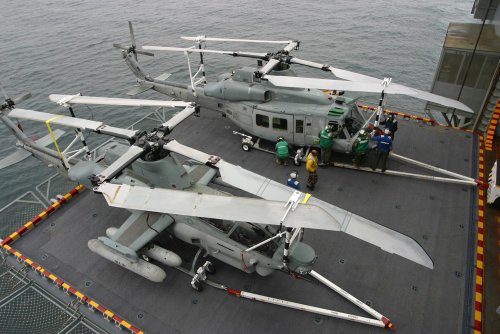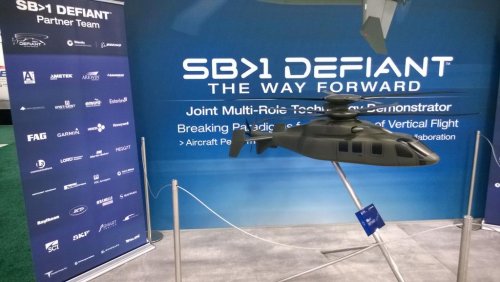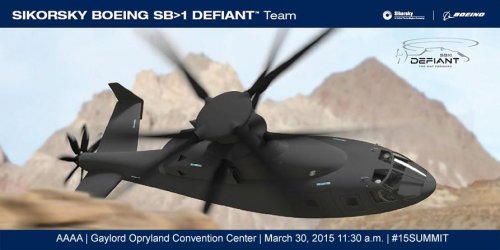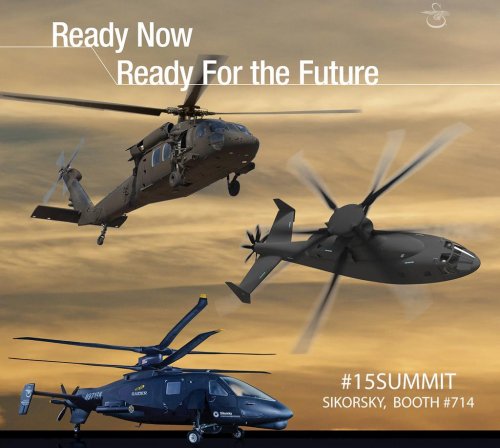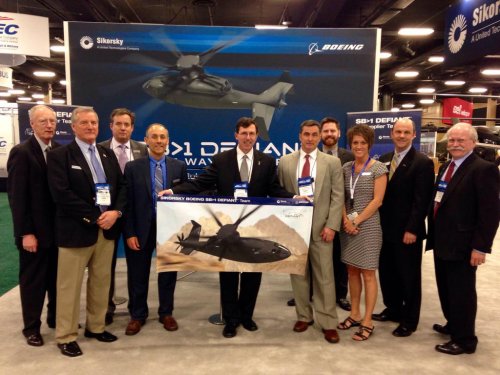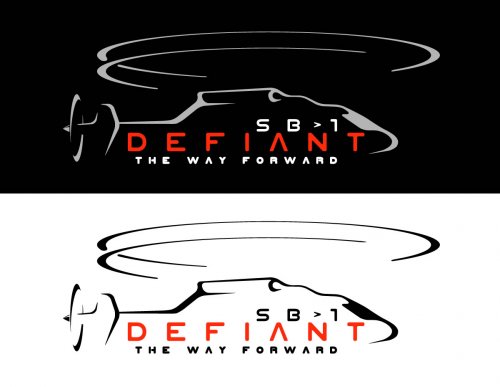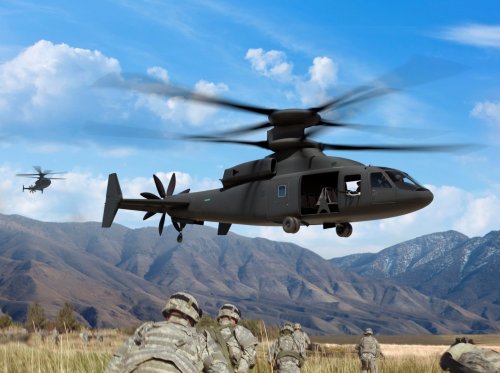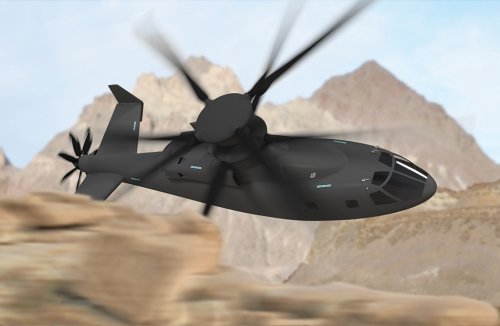Looks like Army Recognition captured the video from a display with another video camera. Hopefully, we can see the original video from Sikorsky.
You are using an out of date browser. It may not display this or other websites correctly.
You should upgrade or use an alternative browser.
You should upgrade or use an alternative browser.
JMR (Joint Multi-Role) & FVL (Future Vertical Lift) Programs
- Thread starter Grey Havoc
- Start date
- Joined
- 11 March 2006
- Messages
- 8,610
- Reaction score
- 3,073
At about 0:55 of this video, with the Raider flying backwards it somehow looks, as
if the prop would stop and then start to turn in the reverse direction ! Cannot really
believe this .... ???
if the prop would stop and then start to turn in the reverse direction ! Cannot really
believe this .... ???
- Joined
- 3 June 2011
- Messages
- 17,342
- Reaction score
- 9,094
Jemiba said:At about 0:55 of this video, with the Raider flying backwards it somehow looks, as
if the prop would stop and then start to turn in the reverse direction ! Cannot really
believe this .... ???
That video was made by an art guy not an engineer.
- Joined
- 16 April 2008
- Messages
- 8,410
- Reaction score
- 10,408
Reversible pitch would not change the direction of rotation.
It's possible it's meant to simulate the stroboscopic effect where the blades can appear to slow down or reverse based on the harmonics between the rotor blade rate and the film frame rate. Or the animator just screwed up.
It's possible it's meant to simulate the stroboscopic effect where the blades can appear to slow down or reverse based on the harmonics between the rotor blade rate and the film frame rate. Or the animator just screwed up.
yasotay said:Yes the prop can go into beta.
Surprised that this is news considering how long we have been discussing X2 Technology.
- Joined
- 3 June 2011
- Messages
- 17,342
- Reaction score
- 9,094
Triton said:yasotay said:Yes the prop can go into beta.
Surprised that this is news considering how long we have been discussing X2 Technology.
I doubt anybody is surprised the pitch is reversible (even the AH-56 Cheyenne did that). The prop looked like it had reversed direction of rotation.
- Joined
- 18 October 2006
- Messages
- 3,884
- Reaction score
- 3,750
That would seem overly complex; adding weight to an aircraft that is likely very weight conscious.sferrin said:Triton said:yasotay said:Yes the prop can go into beta.
Surprised that this is news considering how long we have been discussing X2 Technology.
I doubt anybody is surprised the pitch is reversible (even the AH-56 Cheyenne did that). The prop looked like it had reversed direction of rotation.
I'm interested in three things:
Cabin Volume
Amount of troops carriered
Amount of medevacs possible (so the number of stretchers)
Can anybody maybe help me further with these details on the aircraft? I would be quite thankful
Cabin Volume
Amount of troops carriered
Amount of medevacs possible (so the number of stretchers)
Can anybody maybe help me further with these details on the aircraft? I would be quite thankful
All I know is that the spec is for four crew and 12 troops.
http://youtu.be/BI1u0Kiz6Ws
- Joined
- 24 November 2008
- Messages
- 1,335
- Reaction score
- 1,690
bobbymike said:
“Commonality’s going to be in the cockpit, it’s going to be in the drive trains, things like that,” Lundy said, offering the analogy of the AH-1 Cobra attack helicopter and the UH-1 Huey utility helicopter, both made by Bell with many common parts. “They’re differently configured but have a lot of commonality,” Lundy said. “That’s really where we’re going.”
Two variants - good news! Like the philosophy of the H-1 programm too.
Attachments
- Joined
- 21 April 2009
- Messages
- 13,182
- Reaction score
- 6,081
On the right side of the page under "Related Links" see Army Technology Magazine download all about the future of Army Aviation
http://www.army.mil/article/143354/Army_engineers_define_future_aviation_fleet/
http://www.army.mil/article/143354/Army_engineers_define_future_aviation_fleet/
- Joined
- 21 April 2009
- Messages
- 13,182
- Reaction score
- 6,081
http://www.army.mil/article/143321/
Interview with Dr. Bill Lewis director of the Aviation Development Directorate for the U.S. Army Aviation and Missile Research and Development Center at Redstone Arsenal, Alabama.
Interview with Dr. Bill Lewis director of the Aviation Development Directorate for the U.S. Army Aviation and Missile Research and Development Center at Redstone Arsenal, Alabama.
"Army Engineers: Defining the Future Aviation Fleet"
Posted on March 17, 2015 by yarrington
Source:
http://science.dodlive.mil/2015/03/17/army-engineers-defining-the-future-aviation-fleet/
Posted on March 17, 2015 by yarrington
Source:
http://science.dodlive.mil/2015/03/17/army-engineers-defining-the-future-aviation-fleet/
The Army, supported by NASA and the Navy, is combining its areas of technical expertise to accomplish the aggressive scientific and engineering goals necessary to develop a new fleet of joint aircraft, said Ned Chase, deputy program director of science and technology, or S&T, for the Joint Multi-Role Technology Demonstrator/Future Vertical Lift, also known as JMR TD.
JMR TD has been established to address several of the capability gaps that cannot be satisfied by updating the current fleet.
“Let’s figure out what we want this new aircraft to do, and let’s go out and prove that we have the technologies available to meet those requirements. That’s what we’re doing with JMR TD,” said Chase, with the Army Aviation and Missile Research, Development and Engineering Center, or AMRDEC, on Fort Eustis, Virginia.
The Department of Defense is using JMR TD to design and integrate the technologies that will eventually feed into the Future Vertical Lift, or FVL, and replace the military’s vertical lift fleet with a new family of aircraft.
LEVERAGING EXPERTISE FROM ACROSS ARMY S&T
AMRDEC, one of seven centers and laboratories that make up the U.S. Army Research, Development and Engineering Command, also known as RDECOM, is leading the S&T effort.
Chase and his team are working closely with fellow scientists and engineers within RDECOM to conceptualize research and design the many technologies that will be necessary for this future vertical lift capability.
AMRDEC will leverage its expertise in aviation; however, the team will rely upon its peer organizations for the complementary pieces. For example, RDECOM’s Communications-Electronics Research, Development and Engineering Center at Aberdeen Proving Grounds, or APG, is the expert in areas such as communications systems, sensors and cameras, he said.
“The one thing that we’ve not done in quite a long time was demonstrate that we can build an aircraft from scratch that incorporates the individual technologies that we’ve been working on the past 25 years,” Chase said. “We have the capacity across AMRDEC to populate the aircraft with the right components–engines, rotors, structures, flight controls.
“We want to put together a roadmap to develop the radios, weapons, sensors and survivability equipment by drawing from RDECOM in preparation for FVL. We take their products and integrate them onto the platform itself. FVL is going to reflect the aggregate of RDECOM investment.”
Charles Catterall, AMRDEC lead systems engineer, has worked to develop an S&T integrated product team to build an investment strategy across RDECOM.
“We are engaging our sister organizations within RDECOM. What can the command do to support this program? What resources can be brought to bear to facilitate and support this Future Vertical Lift initiative with technologies? Given a clean sheet, could you bring additional capabilities to bear? We’re looking across the command,” Catterall said.
Catterall said JMR TD has two components–the air vehicle demonstration, or AVD, and mission systems architecture demonstration, or MSAD. Two contract teams–Sikorsky-Boeing and Bell Helicopter–are responsible for the design, analysis, fabrication, ground testing and ultimately, flight testing of the demonstrator aircraft.
The industry proposals for FVL include the capability to carry a payload of 12 troops and four crew, hover out of ground effect at an ambient condition of 6,000 feet and 95 degrees Fahrenheit, and self-deploy 2,100 nautical miles at a speed of at least 230 knots.
The MSAD portion will integrate technology concepts from across RDECOM, as well as the Department of Defense, into an open, efficient, effective and enduring architecture.
The MSAD initiative will develop a standard reference architecture that can be used as the basis for design and implementation of an avionics architecture. This will enable hardware and software reuse across multiple mission design series aircraft and multiple vendor implementations, Chase said.
The knowledge, standards, processes and tools necessary to design and implement such a mission systems architecture that is affordable will be used to inform the government’s generation of requirements for the anticipated FVL program.
Chase said that a major challenge for DoD scientists and engineers is to develop their specific pieces of technologies – whether sensors, weapons, cameras or crew systems–and ensure they function correctly within a much more demanding future aviation environment than exists today.
“This future fleet will be faster and go farther. We’re trying to ensure that the other [research centers] understand how the aviation environment and constraints change when we go from flying aircraft at 130 knots to 250 knots,” Chase said. “The environment we’re creating for weapons, sensors and radios is much different with FVL than the current fleet. FVL will operate in a different performance regime.”
ARMY LEADS JOINT AVIATION PROGRAM
Developing a joint aircraft instead of a separate version for each service is expected to save time and money in technology development, training, maintenance and logistics, Chase said.
There are four classes of aircraft that have been identified for the fleet – light, medium, heavy and ultra.
“We want to develop technology applicable to each of the four basic aircraft of the FVL family, and then populate them with the mission equipment that is required to satisfy each of the service’s missions,” Chase said. “You’re working from the same framework of requirements and technologies.
“You don’t have to do individual technology developments for every single class of aircraft in the fleet. It’s about efficiency of investments, costs and logistics.”
Working with NASA and Navy scientists and engineers brings complementary expertise to the project, he said. Significantly different missions among the services require different skill sets among the aviation subject-matter experts.
“Because it is a joint requirement, it drives you to having a joint team. We have a mixed team to address a comprehensive requirement that neither the Army nor Navy S&T enterprise might be capable of solving entirely by itself,” Chase said.
“The Army operates across land, and we have specific missions – air assaults, attack and reconnaissance. The Navy has a different challenge with operating on the ship, which drives the space that an aircraft can fit on and be maintained in. The Marines Corps has an expeditionary mindset where extended range is extremely important.”
First flight testing is expected in summer 2017. The technologies to be integrated onto the platform should be at technology readiness level 6, or a prototype level, between 2022 and 2024.
While government agencies such as the Defense Advanced Research Projects Agency build single-purpose aircraft, Chase emphasized that the goal of JMR TD is to develop a fleet that will achieve several stringent goals.
“We’re in pursuit of several aggressive individual requirements that in the aggregate is something way beyond what we can do today,” Chase said. “We have to be able to operate all over the world, in any kind of environment, across a speed spectrum that allows us to do our mission anywhere, anytime.”
Story and information provided by the U.S. Army/Army Technology Magazine (March/April 2015)
"LORD Corporation Joins Sikorsky-Boeing Team to Build SB>1 DEFIANT Joint Multi-Role Technology Demonstrator"
Source:
http://www.lord.com/our-company/newsroom/lord-corporation-joins-sikorsky-boeing-team-to-build-sb1-defiant-joint-multi-role-technology-demonstrator-
Source:
http://www.lord.com/our-company/newsroom/lord-corporation-joins-sikorsky-boeing-team-to-build-sb1-defiant-joint-multi-role-technology-demonstrator-
(03/30/2015)
LORD Corporation, a leader in the management of vibration, noise and motion control, has joined the Sikorsky-Boeing team to develop and build the SB>1 DEFIANTTM technology demonstrator for the U.S. Army's Joint Multi-Role (JMR) Technology Demonstrator program.
As a member of the SB>1 DEFIANTTM technology demonstrator team, LORD is responsible for active vibration control systems and tension-torsion rotor head components. LORD was announced as a JMR supplier along with more than 40 other companies during the annual Army Aviation Association of America (AAAA) industry trade show.
"LORD recognizes how vital this program is for the U.S. Army's Future Vertical Lift initiative," said Bill Cerami, President, LORD Aerospace and Defense. "We are excited and proud to be part of the DefiantTM team and look forward to providing solutions that will support the Army's efforts."
Throughout its 90 year history, LORD has commercialized innovative products for the rotary wing industry. For the SB>1 DEFIANTTM technology demonstrator, LORD continues this great tradition by supplying game-changing technologies that will enable new benchmark performance for coaxial rotorcraft.
The Sikorsky-Boeing SB>1 DEFIANTTM technology demonstrator is based on Sikorsky's X2 TechnologyTM rotorcraft design with counter-rotating coaxial main rotors and a pusher propeller, and advanced fly-by-wire system. The Army last year selected the Sikorsky-Boeing team as one of two industry teams to proceed with the development of demonstration aircraft. The two demonstrators are expected to fly in 2017.
Model of Sikorsky Boeing SB>1 Defiant on display at Army Aviation Association of America (AAAA) 2015 aka Quad A.
Sikorsky promotional images for Army Aviation Association of America (AAAA) 2015.
Source:
https://twitter.com/sikorsky
Sikorsky promotional images for Army Aviation Association of America (AAAA) 2015.
Source:
https://twitter.com/sikorsky
Attachments
John21
ACCESS: Confidential
- Joined
- 27 May 2007
- Messages
- 150
- Reaction score
- 11
Has the Army ever looked at tilt jets as a possible eventual successor to the current helicopter fleet? I'm wondering if tilt jets would end up being in conflict with the airforce and key-west agreement in terms of speed, armed fixed wing aircraft and tactical airlift?
- Joined
- 2 August 2006
- Messages
- 3,175
- Reaction score
- 1,160
John21 said:Has the Army ever looked at tilt jets as a possible eventual successor to the current helicopter fleet? I'm wondering if tilt jets would end up being in conflict with the airforce and key-west agreement in terms of speed, armed fixed wing aircraft and tactical airlift?
Tilt jets would be vastly inferior for the mission due to their incredible inefficiency in hover.
John21
ACCESS: Confidential
- Joined
- 27 May 2007
- Messages
- 150
- Reaction score
- 11
Sundog said:John21 said:Has the Army ever looked at tilt jets as a possible eventual successor to the current helicopter fleet? I'm wondering if tilt jets would end up being in conflict with the airforce and key-west agreement in terms of speed, armed fixed wing aircraft and tactical airlift?
Tilt jets would be vastly inferior for the mission due to their incredible inefficiency in hover.
Thank you, didn't know that. Just figured that they would have a few good aspects since they are used so much in military/fps near-future video games. Guess real life physics puts a crimp in that idea. :-[
- Joined
- 18 October 2006
- Messages
- 3,884
- Reaction score
- 3,750
Sadly that is very true. [font=]Unfortunately[/font].John21 said:Sundog said:John21 said:Has the Army ever looked at tilt jets as a possible eventual successor to the current helicopter fleet? I'm wondering if tilt jets would end up being in conflict with the airforce and key-west agreement in terms of speed, armed fixed wing aircraft and tactical airlift?
Tilt jets would be vastly inferior for the mission due to their incredible inefficiency in hover.
Thank you, didn't know that. Just figured that they would have a few good aspects since they are used so much in military/fps near-future video games. Guess real life physics puts a crimp in that idea. :-[
What about the engine exhaust heat of a VTOL jet transport in hover mode and would you want to be underneath that downwash? Or are such concerns myths?
shedofdread
ACCESS: Top Secret
- Joined
- 14 November 2009
- Messages
- 582
- Reaction score
- 354
Triton said:What about the engine exhaust heat of a VTOL jet transport in hover mode and would you want to be underneath that downwash? Or are such concerns myths?
The downwash would be 'significant'
shedofdread said:The downwash would be 'significant', the noise indescribable (think a bunch of Harriers in the hover together) but it's all academic really as the apparent disk loading [relative to something with rotors / BIG fans etc] makes hovering so inefficient... Also, ground erosion, hot gas re-ingestion etc etc. Look cool though

I presume that the Grumman G-698 V/STOL proposal would have had similar issues.
- Joined
- 4 May 2008
- Messages
- 2,440
- Reaction score
- 678
Triton said:What about the engine exhaust heat of a VTOL jet transport in hover mode and would you want to be underneath that downwash? Or are such concerns myths?
To put things in perspective - there are videos of people at a picnic receiving injuries for standing under the downwash of a passing V-22, whose discloading is about 22 lbs/ft^2. At 120 lbs/ft^2, the speed in the downwash is comparable to a category 5 hurricane. A tilt jet is probably above that figure.
- Joined
- 9 October 2009
- Messages
- 19,999
- Reaction score
- 10,533
Triton said:shedofdread said:The downwash would be 'significant', the noise indescribable (think a bunch of Harriers in the hover together) but it's all academic really as the apparent disk loading [relative to something with rotors / BIG fans etc] makes hovering so inefficient... Also, ground erosion, hot gas re-ingestion etc etc. Look cool though

I presume that the Grumman G-698 V/STOL proposal would have had similar issues.
Oddly enough, not necessarily. Grumman's engineers seem to have found a solution in this area, but exactly what it was is still obscure.
shedofdread
ACCESS: Top Secret
- Joined
- 14 November 2009
- Messages
- 582
- Reaction score
- 354
If anyone knows how they were going to achieve that, I'd be fascinated to learn.
"Swift Joins Sikorsky-Boeing Defiant Team to deliver Next Generation Vertical Lift"
Source:
http://www.newswire.com/press-release/swift-joins-sikorsky-boeing-defiant-team-to-deliver-next
Source:
http://www.newswire.com/press-release/swift-joins-sikorsky-boeing-defiant-team-to-deliver-next
Press Release - San Clemente, California - Apr 6, 2015 11:12 PDT - updated: Apr 6, 2015 15:24 PDT
Swift Engineering Inc. joins the Sikorsky-Boeing team to support the development of the SB>1 DEFIANT ™ Multi-Role Technology Demonstrator (JMR TD).
The U.S. Army Aviation Technology Directorate (AATD) selected the Sikorsky-Boeing team to continue the development of the SB>1 DEFIANT™ technology demonstrator, a medium-lift helicopter configured to Sikorsky’s X2™ coaxial design, through flight testing. The DEFIANT™ technology demonstrator will feature counter-rotating rigid main rotor blades for vertical and forward flight, a pusher propeller for high-speed acceleration and deceleration and an advanced fly-by-wire flight control system.
“The DEFIANT™ technology demonstrator truly represents evolutionary advancement in helicopter technology. Sikorsky-Boeing has put together a remarkable team and we are proud to play a key role in this game changing innovation.” says Rick Heise, President and CSO of Swift Engineering Inc. “Our proven track record of developing high-performance, lightweight and cost effective vehicles was a determining factor in Sikorsky-Boeing’s decision to select us.”
A major portion of the airframe structure will be designed and manufactured at Swift’s facility in San Clemente, California by an integrated team comprised of Swift and Boeing employees. The Swift team brings years of experience in composites and advanced vehicle design, working often under constrained, rapid-development time frames.
Attachments
"Army Common Cockpit Effort About Architecture, Backbone Allowing Change"
by Pat Host
Tuesday, April 7, 2015
Source:
http://www.aviationtoday.com/the-checklist/Army-Common-Cockpit-Effort-About-Architecture-Backbone-Allowing-Change_84722.html#.VSbYGpOGMdg
by Pat Host
Tuesday, April 7, 2015
Source:
http://www.aviationtoday.com/the-checklist/Army-Common-Cockpit-Effort-About-Architecture-Backbone-Allowing-Change_84722.html#.VSbYGpOGMdg
The Army views its common aviation cockpit concept as an architecture and backbone that allows a cockpit to evolve over time as opposed to simply components, according to a key official.
"We want to make sure the backbone not only allows the evolution of those vehicles over time but the evolution of the subcomponent," Dan Bailey, Army program director for Joint Multi-Role Technology Demonstrator (JMR-TD) and Future Vertical Lift (FVL), told an audience at the Army Aviation Association of America (AAAA) conference.
Bailey said the Army's JMR TD team is looking at acquistion strategies that would allow such open architecture (OA) approach to future cockpits. Maybe one requirment, he said, is to put in a new architecture in a couple of years. Or maybe there's not an OA characteristic that lasts forever, Bailey said.
Though the common cockpit effort has been years in development, Bailey said that doesn't mean that time has been wasted. The Army, he said, is going through the same ongoing process that allowed Apple's successful iPhone to become what it is today.
"Over time, you learn, and that's the process we're going through," Bailey said. "We're learning and we're understanding."
The Army also views its common cockpit concept as focused on standard software interfaces. Army Program Executive Officer (PEO) for Aviation Brig. Gen. Robert Marion said here Tuesday such an approach makes defining interfaces and standards key.
"If you weren't the original design and development and producer of a cockpit, we can still leverage your capability on a platform in the future," Marion said.
Marion said digitization of the cockpit is an important part of common cockpit evolution. As the Army bought CH-47 Chinooks in the 1960s, UH-60 Black Hawks in the '70s and AH-64 Apaches in the '80s, he said, the service got to to digitization in each of those platforms at different points in time.
Marion said the UH-60V Black Hawk, as the Army's last group of non-digitized aircraft in this enterprise, is the service's opportunity to try to build standard interfaces. This, he said, will allow the Army to move forward with a cockpit design that it could leverage off multiple competitors in the future.
The FVL program is for the Army's next generation of helicopters while JMR TD is a science and technology (S&T) demonstration intended to mitigate risk for the FVL development program through the testing of advanced technologies and efficient configurations, according to the Army. The service, last August, selected Bell Helicopter Textron and a Sikorsky-Boeing [BA] team for the technology and flight demonstration phase of the envisioned JMR helicopter.
Sikorsky and Boeing are developing the SB>1 Defiant, a medium-lift helicopter and derivative of Sikorsky's X2 coaxial design. Honeywell said Tuesday it joined the Sikorsky-Boeing team to develop and build the SB>1 Defiant, providing its current and next-generation Health and Usage Monitoring Systems (HUMS) to the team's flying demonstrator. Honeywell will also provide its T-55 engine, auxiliary power unit generator, air turbine starter and start control valve, according to a company statement.
Bell is developing the V-280 tilt-rotor aircraft for FVL.
"Good things come in threes: Boeing-Sikorsky to develop two larger X2 offshoots for JMR and Future Vertical Lift"
2014-10-16 09:22:37
by Andrew D. Parke
Source:
http://www.verticalmag.com/news/article/GoodthingscomeinthreesBoeingSikorskytodeveloptwolargerX2offs
2014-10-16 09:22:37
by Andrew D. Parke
Source:
http://www.verticalmag.com/news/article/GoodthingscomeinthreesBoeingSikorskytodeveloptwolargerX2offs
Directors of the Boeing-Sikorsky team that is building a technology demonstrator (TD) for the U.S. Army’s Joint Multi-Role (JMR) program said the companies plan to develop three different sizes of the X2/S-97 Raider to present the military with a family of options for the Future Vertical Lift (FVL) effort.
Doug Shidler, director of the JMR TD for Sikorsky Aircraft, and Pat Donnelly, who holds the same position for Boeing, provided an update on the program during an Oct. 14 press conference at the Association of the U.S. Army (AUSA) conference in Washington, DC. The Boeing-Sikorsky team is competing with a group led by Bell Helicopter with its V-280 Valor tiltrotor, which will feature mission systems from Lockheed Martin and engines from GE.
With the JMR tech demonstrator scheduled to fly in 2017, the Boeing-Sikorsky team intends to design an 11,000-pound version of its 6,000-pound X2/S-97 Raider known as the SB>1 Defiant. Then, with the FVL prototype in the post-2025 range, the manufacturers will create a supersized 30,000-pound iteration.
“What’s important about these three elements — the JMR tech demonstrator, FVL and the X2 tech demonstrator — is that they’re in three different weight classes, which is important to demonstrate the scalability of this configuration and architecture,” said Shidler, adding that there will be many steps throughout the JMR and FVL process involving a number of demonstrations.
The JMR demonstrator will incorporate the technology from the X2, which Sikorsky began developing in 2005, followed by the first flight of a demonstration aircraft in 2008 and passing the 250-knot milestone in September 2010. The following year, Sikorsky took the X2 out of service after 23 flights with the start of the S-97 offshoot military variant. Earlier this year, Boeing and Sikorsky announced plans to team on JMR and Future Vertical Lift. The U.S. Army Aviation Technology Directorate chose two teams in August 2014 to enter phase one of the JMR program: Defiant and Valor. Sikorsky rolled out the S-97 Raider prototype on Oct. 2 during an event in West Palm Beach, Fla.
The timeframe for phase one calls for JMR technology demonstrations to occur in 2017. According to Shidler, the U.S. Army will begin the process of conducting an analysis of alternatives (AOA) in about a year, followed by the official kick-off of the program in 2017. At that point, Boeing-Sikorsky will “inform them of what our platform can do, its capabilities in terms of mission execution, and so forth,” he said. Phase one tests the vehicle and fundamental performance attributes, while phase two will focus on mission system architecture, including sensors, navigation, radios and survivability equipment. Initial operating capacity (IOC) is projected for 2034.
In addition to speed, a lift offset coaxial rotor system, retractable landing gear, low-speed maneuverability, decreased downwash, and hot-and-high performance to 6,000 feet/95 degrees F (1,829 meters/35 degrees C) are among the advantages of the JMR configuration, according to Shidler. He noted that the SB>1 Defiant is designed with a maritime application in mind for future Naval applications, including folding blades.
Donnelly pointed out the capabilities of the pusher prop in the back of the aircraft, including acting as a brake to slow down the aircraft using reverse thrusters. “You can back up,” he added, noting that the aircraft can “hover at 20 degrees nose down, 20 degrees nose up with that prop.”
The cabin will carry up to 12 combat troops. “Large troops,” Donnelly explained, noting that the Defiant cabin will be “roughly 50 percent larger than a Black Hawk cabin also designed to carry 12 troops.”
For the technology demonstrator, Boeing-Sikorsky plans to employ the Honeywell T-55, the engine serving the Boeing CH-47 Chinook. Donnelly remarked that while the T-55 provides “more power than we’ll need” for the JMR demonstrator, the team “wanted an engine that had adequate power. It had to be off-the-shelf with a digital flight engine control system."
“People talk about speed,” added Shidler, “but as you execute a mission, simply speaking there are two parts of it — one, the horizontal part of the mission, or speed. Equally important is the vertical side, such as inserting or extracting troops and getting into that tight landing zone. This platform will enable us to get there fast, but also conduct those missions in a confined landing area like a conventional helicopter.”
Published on Jan 22, 2015
Representatives from government and industry discuss the ongoing Joint Multi-Role (JMR) Technology Demonstration effort, which seeks to foster major advances.
https://youtu.be/xbozsza-YfM
Representatives from government and industry discuss the ongoing Joint Multi-Role (JMR) Technology Demonstration effort, which seeks to foster major advances.
https://youtu.be/xbozsza-YfM
jsport
what do you know about surfing Major? you're from-
- Joined
- 27 July 2011
- Messages
- 6,565
- Reaction score
- 3,920
Sponsored by one entity to assure Avx slides were not available. Imagine that. Likewise, 50-50 cost share (slathered on the stage early) to assure no innovation or dismount survival when they need an internally stored vehicle to run w/.

